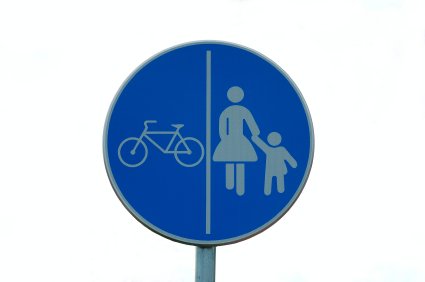 We often discuss the wide ranging benefits of bicycling and walking here, but it’s a message we think needs to be hammered home on a regular basis. Walking and biking are about much more than recreation, although a lot of people see them only through that lens. But we can’t forget about the environment, public health, community, the economy, and social equity.
We often discuss the wide ranging benefits of bicycling and walking here, but it’s a message we think needs to be hammered home on a regular basis. Walking and biking are about much more than recreation, although a lot of people see them only through that lens. But we can’t forget about the environment, public health, community, the economy, and social equity.
- Health: An alarming number of Americans are becoming more sedentary and obese, according to the Center for Disease Control. Even small increases in light to moderate activity will produce measurable benefits among those who are least active. Engaging in light to moderate physical activity reduces the risk of coronary heart disease, stroke, and other chronic and life-threatening illnesses. Physical activity can also improve mental health and even lower health care costs.
- Transportation: Many of the trips that Americans make every day are short enough to be accomplished on a bicycle. The 1995 National Personal Transportation Survey (NPTS) found that approximately 40 percent of all trips are less than two miles in length-which represents about a 10-minute bike ride. Bicycling can help to reduce roadway congestion. Many streets and highways carry more traffic than they were designed to handle, resulting in gridlock, wasted time and energy, pollution, and driver frustration. Bicycling requires significantly less space per traveler than driving. Roadway improvements to accommodate bicyclists can also enhance safety for motorists. For example, adding paved shoulders on two-lane roads has been shown to reduce the frequency of run-off-road, head-on, and sideswipe motor vehicle crashes.
- Environment: Motor vehicles create a substantial amount of air pollution. According to the EPA, transportation is responsible for nearly 80 percent of carbon monoxide and 55 percent of nitrogen oxide emissions in the U.S. Not surprisingly, many metropolitan areas do not meet the air quality standards specified in the 1990 Clean Air Act Amendments. Although individual cars are much cleaner today than they were in earlier years, if total traffic continues to grow, overall air quality will deteriorate. Moreover, every day cars and trucks burn millions of barrels of oil, a non-renewable energy source. Switching motor vehicle trips over to bicycle trips is an easy way to reduce energy needs and pollution emissions from the transportation sector. Motor vehicle emissions represent 31 percent of total carbon dioxide, 81 percent of carbon monoxide, and 49 percent of nitrogen oxides released in the U.S., according to the Clean Air Council. Additionally, 60 percent of the pollution created by automobile emissions happens in the first few minutes of operation, before pollution control devices can work effectively. Since “cold starts” create high levels of emissions, shorter car trips are more polluting on a per-mile basis than longer trips. A short, four-mile round trip by bicycle keeps about 15 pounds of pollutants out of the air we breathe, according to the WorldWatch Institute.
- Economy: Bicycling is an affordable form of transportation. Car ownership is expensive, and consumes a major portion of many Americans’ income. When safe facilities are provided for bicyclists, people can ride more and spend less on transportation, meaning they have more money to save or spend on other things. According to AAA, the cost of operating a sedan for one year is approximately $7,800 and ownership of one motor vehicle accounts for more than 18 percent of a typical household’s income. On the other hand, the cost of operating a bicycle for a year is only $120!
- Quality of Life: Better conditions for walking and bicycling have intangible benefits to the quality of life in cities and towns. The number of people bicycling can be a good indicator of a community’s livability — a factor that has a profound impact on attracting businesses and workers as well as tourism. Comfortable and connected pedestrian and bicycle environments offer alternatives to personal vehicles and increase opportunities for social contact with others. By providing appropriate bicycle and pedestrian facilities and amenities, communities enable the interaction between neighbors and other citizens that can strengthen relationships and contribute to a healthy sense of identity and place.
A video created by the Ann Arbor Energy Office, “Why Walk or Bike?“, offers some more good explanations as to why a solid walking and biking infrastructure is so important on so many levels. For more information on biking and walking programs in the GMTMA region, visit our website.
